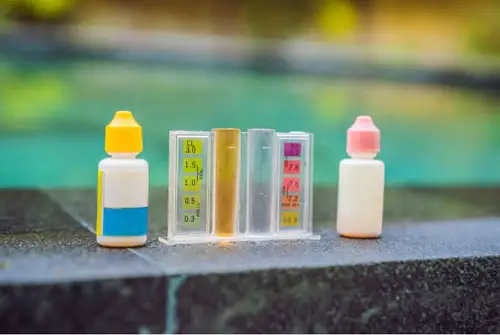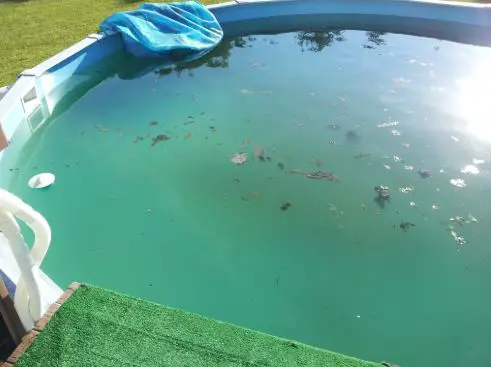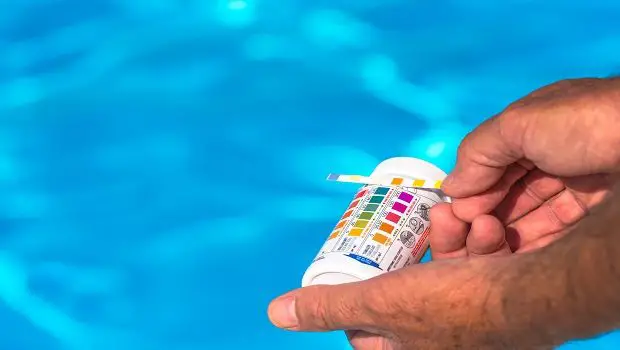ABC’s of Pool Water Chemistry: 5 Chemicals Every Pool Owner Must Know
DISCLOSURE: As an Amazon Associate, I earn from qualifying purchases.
Wouldn’t it be great if you could never be concerned about algae growing, bacteria building up, or your pool water turning into a gross breeding ground for all types of nasty contaminants and organisms- however, all these things can be prevented by knowing your pool’s chemistry.
Sure, adding pool chemicals and testing the water regularly may be time-consuming and dull, but it is vital.
A little up-front work means less remediation after your pool gets so nasty that you must drain it, clean, and refill.
While keeping your pool sanitized and clean is not be the most enjoyable task, it’s not so difficult. All it requires is the right tools and supplies, pool chemistry knowledge, and an urge to maintain your pool’s cleanliness.
Knowing your pool chemistry

You could fill clean, fresh water in your pool, skim it every day, vacuum it – and still, it would get dirty.
Leaves, twigs, and trash fall into your pool.
Insects fall in.
Birds bomb, and fly away.
And every time your kids swim, they leave behind body oils, hair, dead skin, and soap residue that slough off human bodies regularly.
The only thing keeping contaminants from turning your pool into a black lagoon is possibly the most important pool chemical you will use: your sanitizer.
But for your sanitizer to work, other features also have to be balanced, most importantly, your pool water’s calcium hardness, alkalinity, and pH.
On top of that, you may need additional pool chemicals to rid your pool of algae and prevent staining if you have hard water.
All these work together to create balanced pool chemistry so you can swim comfortably.
Sanitizer

No matter what type you use, sanitizer’s job is to keep the water clean from infection – viruses, bacteria, algae, and other biologicals that grow in pool water.
You have a lot of sanitizers to select from.
Chlorine
The most popular pool sanitizer, because of its efficiency and low cost, chlorine cleans your pool by oxidizing pollutants.
Chlorine enters cells and kills them from the inside out.
It is effective at killing germs, bacteria, and algae and help prevent algae from growing.
Chlorine Granules
You pour granules directly into your pool water, where they dissolve and are dispersed by your pool’s filtration system. This is not the most efficient nor effective method.
It is time-consuming, and there is a chance the chlorine will not be evenly dispersed, leaving pockets of not-so-sanitized water around your pool, in addition to pockets of super-chlorinated water that can harm your pool liner.
Chlorine Tablets
Available in 1-inch or 3-inch sizes, chlorine pills are added to a floating chlorine dispenser, right into your pool skimmer basket, or into an automatic chlorinator. Any of these methods for using chlorine tablets provide more even distribution. However, we recommend you use an automatic chlorinator for the best dispersion rate, to handle pills less frequently, and save you time.
Chlorine is also available in two forms: unstabilized and stabilized chlorine.
Stabilized Chlorine
If you own an outdoor pool, you need to use stabilized chlorine to prevent the sun from burning off the chlorine. Stabilized chlorine used cyanuric acid, also called pool stabilizer or chlorine stabilizer, to prevent this.
Cyanuric acid preserves the chlorine so that it remains in the water three to five times longer, which means it does not have to be replaced as frequently. This saves you time and money.
ProTip: When the chlorine you purchase doesn’t explicitly say “stabilized” on the description, check the active constituent. If it is Trichloro-S-Triazinetrione or just Trichlor, it is stabilized.
Important: If a lot of cyanuric acid builds up in your water, it can lower the chlorine’s effectiveness. If that happens, the only way is to dilute your pool water by eliminating chlorinated water and replacing it with fresh water. Or, if there is so much acid that diluting the water will not help, you may need to drain the pool.
Unstabilized Chlorine
Unstabilized chlorine is vulnerable to the ultraviolet rays of the sun. UV light burns the chlorine in the water, decreasing its sanitizing ability. This means you’ll need to add more chlorine to your pool more often, which means you’ll have to spend more money.
So when do you want to use unstabilized chlorine?
If you have an indoor pool, then you do not need to worry about the sunshine eating the chlorine up.
Unstabilized chlorine is also used as pool shock, particularly for shocking a pool at night when there is no worry about sunlight.
ProTip: When the chlorine you purchase doesn’t explicitly say “unstabilized” on the label, check the active constituent. If it is Calcium Hypochlorite or just Cal-Hypo, it is unstabilized. This kind of chlorine is most frequently available in granules rather than tablets.
Add Cyanuric Acid Yourself
Instead of using stabilized chlorine and letting the amount of cyanuric acid-build in your pool water without control, you can use unstabilized chlorine and add cyanuric acid into the pool yourself. This provides you with more control over the amount of acid in your pool water.
ProTip: Keep the cyanuric acid level in your pool water limited to 100 ppm or less.
Chloramines
Through the oxidation process, chlorine disperses and finally becomes a waste product known as chloramine.
When you smell that distinctive “pool odor,” it isn’t the chlorine; it is the chloramines. Chloramines are also what sting your eyes and dry your skin when you swim.
To keep chloramines under control, you need to add chlorine to your pool regularly, as determined from regular water testing.
If your chloramine level gets too high and your pool becomes stinky, you should shock it.
The good thing is, you’re going to be shocking your pool regularly anyway (Right? Right!), so that should help handle chloramine and chlorine levels.
Bromine
The most popular alternative sanitizer to chlorine, bromine acts by ionizing contaminants. This means it breaks a cell’s chemical bonds apart, killing them.
The advantage Bromine has over chlorine is that as it does not break down quite as fast, so it remains active longer.
The downside is that when it breaks down, it generates waste products known as bromamines. While less nasty and smelly than chloramines, they also reduce bromine’s effectiveness. The remedy is the same: shocking the pool.
It’s important to understand that bromine tablets for your pool will not be pure bromine. They’ll have a small fraction of chlorine.
ProTip: the bromine level in your pool water should be maintained at five ppm and never below 3ppm.
Biguanide
Does this sound like a medical substance? That is because it is. Well, it was.
Preservative-free polyhexamethylene biguanide, better called PHMB, is also known as a biguanide.
Biguanide is a chlorine-free sanitizer that was developed as a surgical disinfectant and is very similar to hydrogen peroxide.
Biguanide works by binding contaminants into water-insoluble clumps. This makes it easier for the filter to grab.
The drawback is that it can cause the filter to clog frequently.
So why would you use biguanide?
- Does not create chloramines.
- It is gentler on your skin, hair, and eyes.
- Does not degrade in sunlight.
- It does not turn blonde hair green at the pool.
But it has its drawbacks too.
- It is more expensive than other sanitizers.
- Isn’t as effective as other sanitizers.
- Loses its effectiveness over time.
- May cloud your pool water.
Biguanide is sold under many brand names, the most popular being Baquacil.
Be sure to thoroughly research biguanide before converting your swimming pool from chlorine or bromine.
ProTip: the ideal biguanide level in your pool water is 30-50 ppm. Never allow it to fall below 30 ppm.
Minerals
Have you ever looked at the label a bottle of vitamins and seen metals listed like copper and iron? That’s because they are minerals and are essential to our bodies’ health (in small doses).
Mineral systems of pools also use metals to sanitize water. Especially silver and aluminum.
Silver is a popular bactericide, and copper is occasionally used as an algaecide. When these metals enter the water, they release charged ions that neutralize negatively-charged particles.
Mineral sanitizer systems sometimes also include magnesium chloride and borates as active components, which offer benefits like skin soothers and algae-fighting properties.
It’s essential to understand that mineral systems are not complete sanitizer systems. They’re designed to supplement chlorine or other pool chemicals, reducing the need for so many sanitizers.
ProTip: If using a mineral sanitizer system, the perfect chlorine level in your pool water is 0.5 ppm.
Now that understand the fundamentals of pool sanitizing, let’s examine a few other important swimming pool chemistry features that must be monitored and controlled to keep your pool water safe and clean.
pH

If you remember high school chemistry, pH tells you if something is acidic or basic.
The pH scale ranges from 0 to 14. Anything above 7 is basic, and below seven is acidic.
To illustrate, people’s eyes and mucus membranes possess a pH of 7.4. If it were lower than 7, our tears would be acidic and would burn our eyes when we cry. If it were higher, our eyes would dry out.
Anything that enters your pool can impact the pH level. Dirt, rain, people, leaves, anything.
Due to this, it is essential to maintain the pH level of your pool within the optimal range.
To do this, you need a supply of 2 pool chemicals: pH increaser and pH decreaser.
You will probably use less decreaser because of how alkalinity is improved, but it is better to keep some on your cabinet just in case.
ProTip: the perfect pH level in your pool water is 7.4 to 7.6. This creates an environment for chlorine to perform its job and will prevent water from stinging your eyes.
Alkalinity

This pool chemical’s first job is to prevent the pH from radically moving up and down the scale by acting as a buffer and absorbing significant changes to the water until it can impact the pH.
To keep alkalinity stable, keep a supply of alkalinity increaser available. If both the alkalinity and pH are low, an alkalinity increaser will increase both. It is another reason to adjust alkalinity first.
An alkalinity decreaser is not available as a separate pool chemical. So if your alkalinity and pH are both high, pH decreaser will reduce both. Lower the alkalinity by adding a pH decreaser first. Yes, this will also lower pH levels further. Once the alkalinity is where it requires to be, work on bringing the pH back up with pH increaser.
An abnormal pH situation might take several tries to get the levels back to normal, so make changes gradually to refrain from throwing things even further out of whack.
If alkalinity is astronomically high and everything fails to lower it, you might also try to reduce it using muriatic acid.
Important: Since alkalinity maintains pH, you always balance alkalinity first, then adjust its pH. At times, it was getting alkalinity, where it needs to also bring pH in line.
ProTip: the suggested alkalinity range in your pool water is 100 ppm to 150 ppm, with 125 ppm being ideal.
Calcium Hardness
A determination of how soft or hard your pool water is, calcium hardness may change based on your location, and what water supply you use to fill your pool.
In particular, well water is usually higher in minerals like calcium than water that coming from a city water treatment plant.
If your pool water’s calcium level is low, it can result in corrosion and scaling of your pool gear and walls. This is remedied by adding a calcium hardness increaser.
If minerals are too high, you can wind up with cloudy pool water, which may be addressed by shocking the pool, including flocculant, adding pool clarifier, or some different procedures.
Note: High pH can also lead to high calcium hardness. So before trying to tackle a high calcium level, adjust the pH first.
ProTip: the perfect calcium hardness level in your pool water is 175 ppm to 200 ppm, and 200 ppm to 275 ppm for plaster – and for concrete pools, 225 ppm.
Shocking Your Pool
No matter how well you maintain your pool chemistry, it is necessary to regularly shock your pool.
Shocking your pool is sometimes known as super chlorinating, as all it means is adding a high amount of chlorine to the pool all at once.
Shocking is excellent to keep your pool water clean and clear. However, it is also a remedy for matters like pool algae, and inevitable physiological mishaps that might happen in the pool, especially if small children swim.
For the best results, we suggest using calcium hypochlorite shock at least once weekly.
If you own a chlorine-free pool, you can also find chlorine-free shock.
ProTip: Pool shock is made with unstabilized chlorine that will get consumed by the UV rays of the sun quickly. So, make sure you shock your pool at dusk or night and run the pump overnight to thoroughly distribute it and let it dissipate.
Note: Products that contain calcium, such as calcium hypochlorite, can increase the calcium hardness level of your pool over time. Monitor your calcium hardness levels so that you can fix it before this becomes an issue.
Other Pool Chemicals You Need

You can keep your pool healthy and clean throughout the year if you just control pH, sanitizer, alkalinity, and hardness- and having adequate pool chemistry knowledge to do so.
Of course, we don’t live in a perfect world, and there will be times when you have to help your pool battle specific enemies – things like algae, cloudiness, and staining.
Fortunately, you have an assortment of pool chemicals available to fight these enemies off.
Algaecide
Your best shield against algae is a sanitizer, especially chlorine. By maintaining the chlorine level, algae will be kept under control.
But water sometimes becomes unbalanced, and algae grow undetected until you have a blossom spreading and growing through your pool.
We suggest shocking your pool first to destroy algae. Depending on the type of algae growing, you might need to double- or triple-shock the pool.
As soon as you get chlorine level back to normal, though, you can use an algaecide to double down. Despite its name, it will not completely kill the algae, but it can at least keep the algae from proceeding to grow and spread.
ProTip: If your pool water is hard and contains high levels of minerals, make sure to use a copper-free algaecide. This will help avoid staining your pool walls and flooring and raising mineral levels much more.
Clarifier and Flocculant
There’s a significant difference between pool clarifier and flocculant:
One treats the symptom, while the other treats the cause.
A clarifier is excellent to have on hand if you wake up to a cloudy pool on the day you are hosting a pool party.
You do not want your pool to look uninviting, and you do not want your visitors to hurt themselves leaping into the pool when they can’t see the bottom. So you use a pool clarifier to instantly clean the water. Just remember that it’s only temporary, and after the clarifier dissipates, the dirt will return.
So what you have to do is deal with the cause. That is the job of flocculant.
When you add flocculant – also called floc – it causes the water-clouding particles to clump together and sink to the bottom of the pool. The only way to eliminate them is to vacuum the pool.
ProTip: You will see flocculants that use the term “pool clarifier,” but you will never see the pool clarifier tagged as “flocculant.” If it’s floc you want, look for that on the label.
Metal Sequestrant
Another thing that you should know about pool chemistry is that if you find green or rust-colored pool stains, your water contains metals such as copper and iron.
To eliminate these stains and to prevent them from reoccurring, use a metallic sequestrant.
This pool chemical attaches to metal particles in the water so that they cannot settle on surfaces. You may need to keep sequestrant handy if you use well water or hard water to fill your pool, as these sources often contain trace metals.
Testing, Testing

Understanding your pool chemistry is only half the battle.
There is no way to know what your chemical levels are without frequent and proper pool water testing.
If you are doing things correctly, you will test your pool more often than you do anything else.
Before you add chemicals, test it.
After you add chemicals, test it.
After a rainstorm or pool party with a lot of swimmers: test, test, test.
The quickest and easiest way to test your pool water is with test strips.
If you desire a more detailed and precise reading, use a liquid test kit.
If you are into gadgets and tech, you may even receive a digital water testing kit.
NOTE: Check out our roundup of the best pool water test kits for great choices of all three types of test kits
Also, at least once a quarter, take a pool water sample into the regional pool shop and test it with their more comprehensive and precise testing skills.
Now You’re a Pool Chemistry Expert

Hey, no one ever said using a pool would be simple.
But it does not have to be hard.
Knowing your pool chemistry and the right chemicals can make a big difference.
Now: go take a swim.






